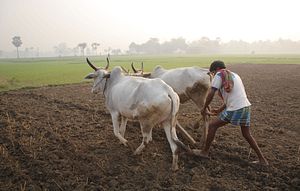The annual budget of India is often an expression of not only the economic direction of the country over the coming year, but also the political intentions of the ruling party. The 2016 budget, which was presented in the Indian parliament on Monday, however, contains more political substance than economic heft. It reveals the political thinking of the Bharatiya Janata Party (BJP) government. The emphasis on rural India and social welfare clearly establishes the fact that Prime Minister Narendra Modi’s government is focused on appeasing political constituencies rather than introducing long-promised reforms.
Before coming to power, Modi promised a new generation of economic and structural reforms. He used to castigate the social policies and subsidy regimes of the previous Congress government. It is this promise that galvanized the middle-class and corporate India in favor of his candidacy. Therefore, for many, the BJP’s dithering on reforms, as exhibited by the latest budget, is baffling.
“It is the politician’s budget. It is not a finance minister’s budget,” says Nilanjan Mukhopadhyay, a political commentator. “The budget is driven by the necessity of politics, which is to recover the lost political ground of 2015 and to ensure that in 2016, the ground recovers so that 2017 onwards, Modi can begin an upward climb toward the next parliamentary elections in 2019. This is a serious attempt at course correction,” adds Mukhopadhyay, who is the author of a biography of the Indian prime minister.
The $290 billion budget is predominantly tilted toward India’s farm sector, which has been in great distress for the last two years. A whopping $5.20 billion has gone into agriculture and farmer welfare, including huge spending on irrigation facilities to reduce monsoon dependency. About $300 million is earmarked for providing cooking gas connections to rural households.
Meanwhile, over $5.5 billion dollars has been given to the Mahatma Gandhi National Rural Employment Guarantee Act (MGNREGA), which provides a guaranteed 100 days a year of employment to Indians in rural areas. This was one of the flagship programs of the previous Congress government, which brought the party electoral success in 2009. When Modi came to power in May 2014, he diluted the funding for this rural job scheme and termed it as a “living monument” to the Congress government’s failures.
“The government is keen on an image makeover,” explains Paranjoy Guha Thakurta, an editor designate of the Economic and Political Weekly. “The government has been conscious of the fact that it is being branded as a regime disposed favorably towards corporations and rich people. Modi wants to shake off that image by emphasizing farmers and the poor,” says Thakurta, a long-time observer of politics and economics in India.
The same sentiment is echoed by Rajiv Kumar, a senior fellow and economist the Centre for Policy Research (CPR), a New Delhi-based policy think tank. “Yes, there is a politics in the budget,” asserts Kumar, who was among the ardent critics of the previous government’s social schemes.
Commenting on Modi’s pro-farmer tilt, he says that “the Indian prime minister wants to give the impression that his government not only caters to the corporate sector, but also works for the poor. This is a good budget I feel. The government’s efforts to shrink the fiscal deficit are commendable. Instead of going in for an ideal budget, Modi has presented a realistic budget that takes care of almost all sections of Indian society.”
One section which is feeling left out from this year’s budgetary exercise is the middle class, which has been the backbone of the Modi government. No tax rebates were doled out for the middle class; indeed, additional tax burdens have been imposed with the new budget.
“The message is that the middle class is quite well off and it is the poorer section that Modi wants to help through the budget,” says Kumar, who was secretary-general of the Federation of Indian Chambers of Commerce and Industry (FICCI).
“The budget potentially alienates the middle class. My argument is that Modi would like to offset this erosion in support among the middle class by giving them a more majoritarian platform, which has already started with the controversy gripping Jawaharlal Nehru University. Basically the right-wing groups are moving into widening the majoritarian plank by making it more ultra nationalistic. Ultra nationalism combined with economic populism is a deadly combine,” says Mukhopadhyay.
With the 2016 budget, the ruling BJP has pivoted politically and is making a huge political gamble. Its success will depend on delivery, which is not easy considering the experiences of past governments. The fact, however, remains that Modi’s economic policy is largely turning out to be a continuation of what the Congress-led United Progressive Alliance (UPA) government put in place during its decade in power.
For many in India, Modi still has to deliver the change he promised in May 2014, and the 2016 budget does not fulfill that promise.

































